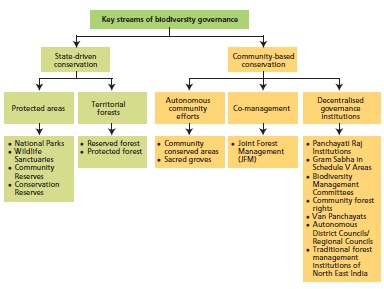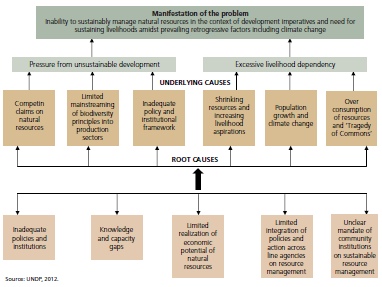
Chapter 1: Background
Biodiversity conservation has normally followed one of two approaches-
- Setting aside protected areas
- Community-based conservation.
The former was usually preferred by governments and global agencies, and as of today 12.7% of the global land area is protected to some extent. However, this does not translate into the protection of a representative sample of biodiversity. This approach also tends to exclude communities who have been the traditional managers of these ecosystems.
These reasons have led to an increased interest in community conservation.This model recognises that the environment and 'development' need not be mutually exclusive, and also recognises the role that communities have played in resource management. This chapter discusses these two approaches and explores the reasons behind the interest in community-based conservation. The debates over these two approaches, especially in the Indian context are also presented.
The book clarifies that neither of these two approaches are complete in itself, and describes the continuum that most conservation efforts stretch across. It also makes an argument for the 'landscape approach' which is described as a focus on 'large, connected geographic areas to allow for recognition of natural resource conditions and trends, natural and human influences, and opportunities for resource conservation, restoration and development'.
This is illustrated through the five governance models discussed in this book. The concept of participation is also debated. The governance models discussed are as shown in figure 1.

Chapter 2: Profile of India’s biodiversity
This chapter presents an overview of India's biodiversity, the threats to this natural heritage, and the policies that govern it. It begins with a description of India's biogeographic zones and various ecosystems.A map of India's main biogeograhic zones is included.Statistics are presented for India's faunal, floral, crop and livestock diversity as also the extent of endemism.India's cultural heritage as it relates to biodiversity, in terms of its sacred groves, traditional ecological knowledge, and medicine systems is explained. Habitat loss, fragmentation and degradation, over-exploitation, pollution, invasive species, and climate change are discussed for the threats they pose to biodiversity. The National Forest Policy, National Conservation Strategy, National Policy on Biodiversity and the National Environment Policy are among those discussed for the way they shape India's efforts at conservation. The various protected areas and also the issue of sustainable sharing of resources is discussed.
Chapter 3: Protected areas – Reservoirs of biodiversity
Protected areas comprise just below 5% of India's land, and are considered indispensable tools towards biodiversity conservation. With the shift towards including forest communities in the governance of protected areas, they also safeguard subsistence rights. This chapter discusses the legal framework for the various categories of protected areas in India. The planning framework for the identification, notification and governance of protected areas-including flagship programs such as Project Tiger- is explained. With it's delineation of management methods, red listing, involved agencies, recovery programme, training programmes, ex-situ conservation efforts, transboundary protected area, and of the challenges faced by these areas, this chapter provides an exhaustive view of protected area extent and governance in India.
Chapter 4: Autonomous conservation efforts – Community conserved areas
India has a rich tradition of community conserved areas in every bioregion. These areas not only serve to conserve biodiversity, but also act as corridors and enhance wildlife conservation efforts. In addition, they safeguard diverse landscapes and coastal areas. This chapter takes a look at the reasons and motivations for this conservation, the extent of these areas, supporting legal and policy framework, governance methods and the mechanics of conservation. These areas are now being threatened from both within and outside these institutions. The various challenges are detailed, along with means of meeting them.
Chapter 5: Territorial forests – A multiple-use resource base
Territorial forests are those that are controlled by the state forest departments. These are governed with multiple management objectives in mind, including biodiversity conservation, timber and NTFP production and as a source of livelihood to forest communities. They constitute the largest area of the five governance systems mentioned in this book, and also a large array of forest types.These ensure connectivity between protected areas and also host several species. This chapter discusses the importance of these forests as a tool for climate change resilience and adaptation. The evolution of forest policy and sustainable forest management. The legal and policy instruments as also the institutions that govern these forests are listed and described. The mechanics of forest management, including planning, forest cover assessment, research and training, and certification are explained. Like other forested areas, territorial forests are also threatened by fragmentation, over extraction,and institutional challenges among others.
Chapter 6: Joint forest management – Co-management of biodiversity
Over one lakh Joint Forest Management committees manage about 30% of India's forest cover.The goal of this endeavour is to ensure biodiversity conservation in tandem with the sustenance of forest communities. This chapter examines the extent, mechanism, success and challenges of joint forest management. The contribution of the National Forest Policy of 1988 to this concept, the 1990 guidelines for JFM, and the revised guidelines in 2000 and 2002 are listed and explained. The mandate and structures of the joint forest committee, ecodevelopment committee, forest development agency are described. The effectiveness of JFM in biodiversity conservation, benefit sharing, gender awareness, and sustainable planning are discussed.
Chapter 7: Decentralized governance of biodiversity
The devolvement of key responsibilities to panchayati raj institutions paved the way for decentralised governance of forest resources, which means that villages take responsibility for the conservation and use of their forest resources. These can be through the mechanism of the 73rd Amendment , the Forest rights Act, the Biodiversity Act, Community Conserves, etc. This chapter examines these several mechanisms of decentralised governance. For each, it describes the evolution of governance, extent of forest governed, success stories and the challenges faced by these institutions. Decentralised governance in North East India is accorded special focus through the lens of Schedule VI which designates tribal areas in Assam, Meghalaya, Tripura and Mizoram as autonomous districts. Areas that are outside Schedule VI, or the 73rd and 74th Amendments are also discussed, such as the Nagaland Village Council Act. In addition to the North Eastern States, decentralised forest management in Uttarakhand and Odisha are described. Evolving initiatives for decentralised governance such as Tree Growers' Cooperative Societies and Community Reserves are also explained.
Chapter 8: The future of biodiversity governance in India
While the previous chapter laid the foundation for a thorough understanding of the extent of biodiversity in India, and the various mechanisms that exist for its conservation, this final chapter takes a more speculative approach. The institutional, knowledge, and social challenges to effective biodiversity conservation are enumerated. Valuation of ecosystem services, and incorporating conservation into commercial activities, using intersectoral coordination to manage marine biodiversity, optimising the use of NTFP for conservation, revamping the joint forest management programme, ensuring greater political recognition to community conserved areas, increasing production forestry to meet the demand for wood and related products, capacity building, incorporating ecosystem sensitivity into development planning, and landscape management are some of the methods discussed that may improve the status of biodiversity conservation.

The following appendices are included in the book
Annexure 1: Strategic Goals and the Aichi Biodiversity Targets
Annexure 2: List of wetlands of international importance (Ramsar sites) in India
Annexure 3: Estimated faunal diversity of India
Annexure 4: Estimated floral and micro-organisms diversity of India
Annexure 5: Endemism in selected faunal groups in India
Annexure 6: Endemism in different floral groups in India
Annexure 7: Summary of protected area statistics in India
Annexure 8: Tiger Reserves in India
Annexure 9: Tiger status with regard to forest occupancy and estimated population (2006-2010)
Annexure 10: List of landscapes and Elephant Reserves in India
Annexure 11: National level forestry research and training institutions
Annexure 12: Rights conferred on communities, Gram Sabhas and individuals by the Scheduled Tribes
and Other Traditional Forest Dwellers (Recognition of Forest Rights) Act, 2006
This book provides an exhaustive discussion of the policies and laws that support the various mechanisms of biodiversity conservation in India. It provides data and resource material on biodiversity and associated policies. This makes it an invaluable resource for students and people working in natural resource management.
Download the entire book here.
/articles/conservation-across-landscapes-study-various-mechanisms-biodiversity-conservation-india